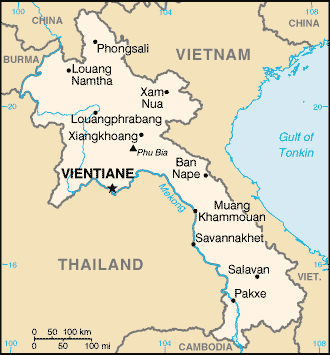Laos: Difference between revisions
imported>Denis Cavanagh (Add map) |
imported>Denis Cavanagh |
||
| Line 21: | Line 21: | ||
==Demography== | ==Demography== | ||
As of an estimate by the United State's [[Central Intelligence Agency]] in July 2007, Laos has a population of around six and a half million persons; her ethnic groups comprise the following; [[Lao Loum]] (lowland) 68%, [[Lao Theung]] (upland) 22%, [[Lao Soung]] (highland) including the [[Hmong]] and the [[Yao]] 9%, ethnic Vietnamese/Chinese 1%. <ref>Ibid</ref> | |||
Lao's religious groups comprise the following; [[Buddhism|Buddhist]] 65%, [[Animism|animist]] 32.9%, [[Christianity|Christian]] 1.3%, other and unspecified 0.8% (1995 census) | Lao's religious groups comprise the following; [[Buddhism|Buddhist]] 65%, [[Animism|animist]] 32.9%, [[Christianity|Christian]] 1.3%, other and unspecified 0.8% (1995 census) | ||
==History== | ==History== | ||
Revision as of 07:35, 8 January 2008
Laos or the Lao People's Democratic Republic is a landlocked south east Asian country, bordered by Cambodia, Vietnam, Burma, China and Thailand.
Government
The Communist Pathet Lao assumed control of the country in 1975 and followed a close diplomatic relationship with bordering Vietnam. Laos has gradually liberalised its economy since 1986.
Geography & Natural History
Laos is a landlocked country which is covered mostly by rugged mountains, though there are some Plains and Plateau's. Phou Bia is the largest mountain, standing at 2,817 metres. [1]
Economy
The Communist government of Laos began the process of economic Liberalisation in 1986. The results displayed sharp economic growth; GDP increases averaged around 6% every year between 1986-2006, except a short blip caused by the Asian Financial Crisis in 1997. Despite high growth, the infrastructure in underdeveloped. There is no national rail system and roads are primitive at best. Electricity is largely confined to larger population centers. Subsistence Agriculture accounts for around half of GDP and 80% of employment. In late 2004 Laos gained normal trade status with the USA, allowing Laos exporters to benefit from lower trading tariffs.
China and Vietnam are trading partners with Laos, but Thailand is particularly important to the future growth of the Laos economy.
Demography
As of an estimate by the United State's Central Intelligence Agency in July 2007, Laos has a population of around six and a half million persons; her ethnic groups comprise the following; Lao Loum (lowland) 68%, Lao Theung (upland) 22%, Lao Soung (highland) including the Hmong and the Yao 9%, ethnic Vietnamese/Chinese 1%. [2]
Lao's religious groups comprise the following; Buddhist 65%, animist 32.9%, Christian 1.3%, other and unspecified 0.8% (1995 census)
History
See Laos, History
References
- ↑ See CIA World Factbook; https://www.cia.gov/library/publications/the-world-factbook/geos/la.html
- ↑ Ibid
